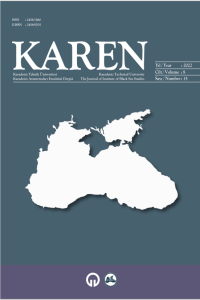Tanzimat Sonrası Gayrimüslimlerin Mimari Faaliyetleri: Samsun Kasabası Kiliseleri (1866-1990)
Architectural Activities of Non-Muslims after the Tanzimat: Samsun Town Churches (1866-1990)
Author(s): Vedia Derda TaşarSubject(s): Christian Theology and Religion, Museology & Heritage Studies, Architecture, Recent History (1900 till today), Sociology of Culture, 19th Century, The Ottoman Empire
Published by: Karadeniz Teknik Üniversitesi - Karadeniz Araştırmaları Enstitüsü
Keywords: Non-Muslim; Church; Ottoman Architecture History; Samsun; Tanzimat;
Summary/Abstract: After the Tanzimat Reform (1839) in the Ottoman Empire, the decisions that facilitated the construction of public buildings such as places of worship and schools for non-Muslims also increased their architectural activities in the cities. Non-Muslims have prepared architectural projects and applied for the construction of many buildings, primarily places of worship. These applications were recorded by the Ottoman Empire and building permit documents were prepared. In this context, Samsun is an important settlement where there are many records about the construction of places of worship and schools by non-Muslims. From the Tanzimat to the War of Independence (1914), five churches and schools and guesthouses affiliated to the churches were allowed to be built in Samsun Town. Both in terms of location choices and architectural features, these churches are important in terms of showing the prominent places of non-Muslims in the urban structuring. Afterwards, most of these places of worship were first transformed functionally, underwent formal changes and then demolished. In the transformation process of the churches, where only one structure can reach today, the place they have acquired in the memory of the city has been special and different.This study deals with the churches built in Samsun Town after the Tanzimat, with their construction decisions, their roles in the city structure and their architectural qualities. The study aimed to determine the position of non-Muslims in the social and political context of the city through churches. In this context, primary sources were accessed from the State Archives and archive documents were directly analyzed. The study offers a holistic perspective by examining church structures in the context of city scale. First; Starting from 1866, when the first church was built after the Tanzimat, churches and other structures that were allowed to be built together with them were examined with Ottoman archive documents and existing photographs. After 1914, the functional and formal transformations of the churches and their new usage in the city organization were determined by documents, newspaper reports and other written documents and transferred in the second part. The findings of both periods were analyzed in the evaluation section and the building permits of non-Muslims, the choice of location in the city and their socio-cultural interactions were compared. As a result, the study reveals the lost cultural heritage of non-Muslims in Samsun Town, while also discussing the value transformation of this heritage in the process.
Journal: Karadeniz Araştırmaları Enstitüsü Dergisi
- Issue Year: 8/2022
- Issue No: 15
- Page Range: 239-271
- Page Count: 33
- Language: Turkish

